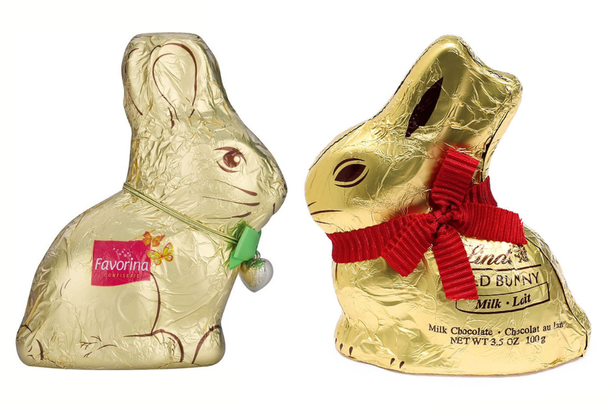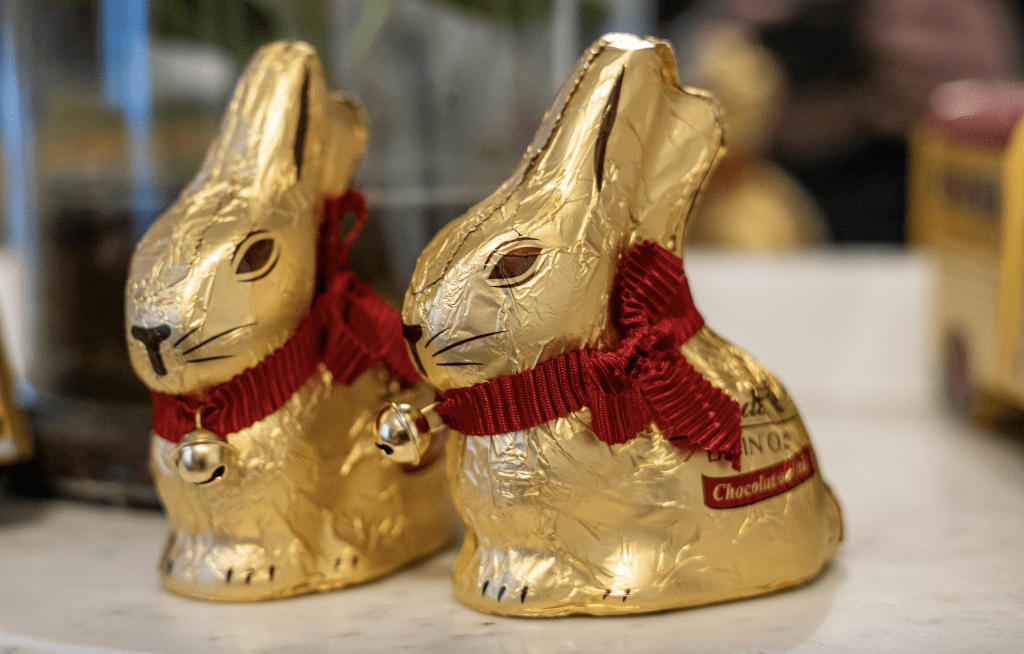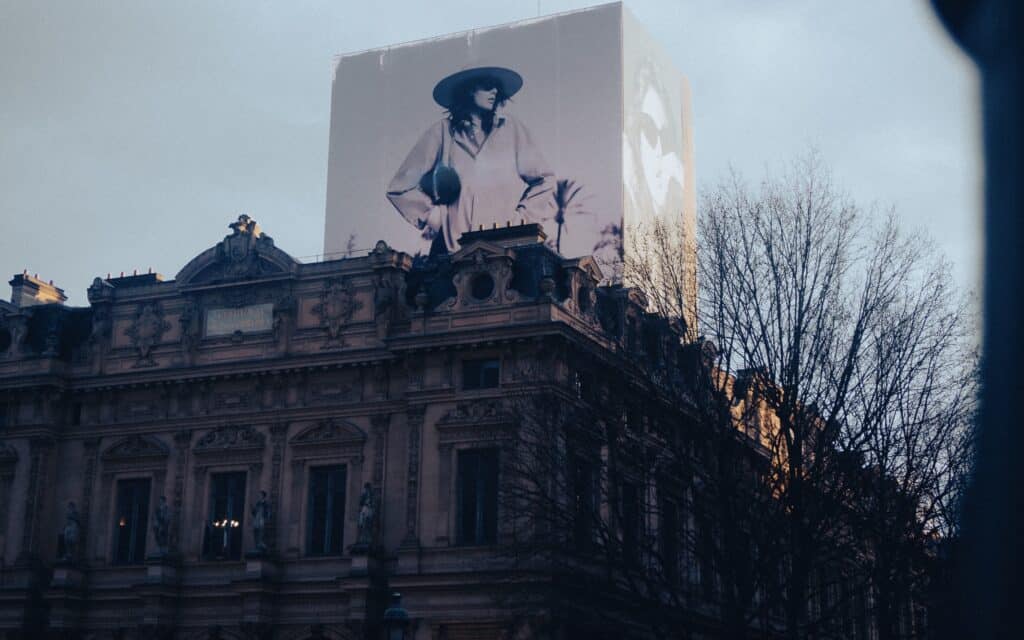In a move that surely upset chocolate-lovers everywhere, discount supermarket Lidl was ordered to destroy its stock of chocolate bunnies back in August 2022. The cull – which was ordered by a Swiss court that decided that the German grocery chain’s bunny was too much like Lindt’s iconic chocolate rabbit – comes after Lidl was sued by Swiss confectioner Lindt & Sprüngli for selling a golden foil-wrapped chocolate bunny that Lindt alleged was too similar to its own product and likely to lead to consumer confusion. The Swiss federal supreme court ruled that the Lindt Gold Bunny is, in fact, a valid “shape” trademark, and as a result, other companies can be barred from replicating this shape when selling their own chocolate products in Switzerland.
The closely watched case hinged on the distinctiveness of the shape of the Lindt bunnies. At the time the case was initiated, the Swiss chocolate-maker had been selling a milk chocolate bunny wrapped in gold-colored foil with a red ribbon and a bell around its neck for nearly 70 years, and had registered two 3-dimensional trademarks for the product in Switzerland. One of the registrations extended to a black and white version of the bunny and its packaging, while the other encompassed the gold, brown, and red color scheme of the product/packaging.
European trademark law states that companies can only register something as a trademark – and therefore, protect it from imitation – if it allows consumers to distinguish the specific product from those of competitors. In other words, the mark must be distinctive (either inherently or as a result of acquired secondary meaning.) In an attempt to chip away at Lindt’s trademark claims, Lidl argued that the shape of the company’s bunnies was little more than a commonplace – and non-distinctive – design, and so it should not qualify for registration.
Siding with Lindt, the Swiss court based its decision that Lindt bunny shape is a valid trademark on consumer surveys that showed that consumers unequivocally associate the shape at issue with a single source: Lindt.

That case was not the first time that the Lindt bunny had ended up in court. Heilemann, a Lindt competitor in Germany, started selling golden bunnies in 2018, prompting the Swiss chocolatier to sue for trademark infringement. Lindt’s strategy was slightly different in this case, with the company focusing on protecting the color of the bunny packaging rather than the shape. It claimed that the specific golden shade of the foil wrapping is distinctive enough to be protected as a trademark with respect to chocolate bunnies. The German court agreed, again relying on a consumer survey in response to which 70 percent of respondents said the golden shade in question called to mind Lindt’s products. The court took into account Lindt’s extensive and successful use of this shade and its acquired distinctive character.
The Lindt bunny has not always come out on top, however. In an earlier ruling in 2012, the Court of Justice for the European Union found that the combination of the Lindt Gold Bunny shape and colors (including the pleated red ribbon and attached bell) were not sufficiently different from the way other chocolate products are wrapped, especially rabbits, to warrant trademark protection in the EU.
The Shape of Things to Come
Trademark disputes over the shape of products are hardly novel territory. In many cases, though, courts find shapes to be too commonly used in a specific market to be protected as trademarks. Kit Kat chocolate bars, for example, were the subject of efforts by food producer Nestlé to register its four-fingered 3-dimensional shape as a trademark. In the United Kingdom, confectioner Cadbury challenged this attempt, successfully claiming that the shape lacked distinctive character. A similar decision was reached by European courts.
American beverage giant Coca-Cola failed in its attempt to register an update to its coke bottle because the shape did not produce a clear and unmistakable impression of exclusively being linked with a single source. Of course, the original Coca-Cola bottle shape is widely associated with the drinks-maker and is, therefore, already registered as a trademark in many countries. Coca-Cola’s attempt to register an updated version in plastic, metal, and glass as a trademark was rejected in 2014. According to EU courts, the new version was “devoid of any distinctive character” and not, as Coke attempted to argue, “a natural evolution of its famous iconic bottle.”
Meanwhile, Christian Dior was handed a loss last year in connection with a well-known shape of its own, with the Second Board of Appeal of the European Union Intellectual Property Office refusing to register the shape of its Saddle bag for use in connection with various types of leather goods, including bags, as a 3-dimensional trademark, on the basis that the shape lacks distinctiveness – and “would be regarded as ‘typical’” – when used on handbags. (Meanwhile, in the U.S., Dior previously sought to register the shape of its Saddle bag as a 3-dimensional mark for use on “coin purses; bags in the nature of purses, clutches and handbags; handbags; leather clutch bags,” but abandoned that application following pushback from the U.S. Patent and Trademark Office.)
This is not to say that the shapes of all products are difficult to protect. The pyramid shape of Toblerone, believed to be a replica of the Alps’ Matterhorn mountain, for example, is a registered trademark in various jurisdictions and is owned by the U.S. company Mondelez. This mark was enforced in the United Kingdom several years ago when a competitor launched a similarly shaped chocolate bar it called Twin Peaks. At the same time, the familiar shape of the Ferrero Rocher chocolate praline and four of its transparent packaging types have also been successfully registered as trademarks in several countries on the basis that the shape is well-known to consumers (again, as revealed by surveys) and the company has a long history of using imagery of these items (i.e., look-for advertising) to distinguish its products.
Protecting Consumers
Non-distinctive shapes usually cannot be registered as trademarks because the law endeavors to protect the right of all companies to use shapes that are common. Generally, only signs and symbols that help consumers identify products can be registered (in connection with specific goods/services) and therefore, monopolized – to an extent – by a single firm. On the other hand, shapes that have been used regularly and for a long time by a variety of manufacturers will face pushback from a registration perspective given that they will not function to assist consumers in making informed purchasing decision.
Also of importance is the fact that the monopoly offered to trademark owners can be perpetual, assuming, of course, that the marks at issue are being used/enforced in a consistent manner. Registrations can be renewed every ten years as long as fees are paid. So, being able to monopolize common product shapes, such as chocolate bunnies, could have a negative and lasting impact on competition; although it is also worth noting that registrations can be subject to legal challenge and in many cases, defendants have made such challenges in response to trademark actions waged against them.
Trademark disputes over product shapes will keep unfolding and courts should continue to use consumer surveys to come to decisions about who, if anyone, owns certain product shapes. As we have seen, this will not prevent judges from different jurisdictions from reaching different decisions over the same cases, but it will at least keep consumer protection uppermost in mind when making these judgements.
Enrico Bonadio is a Reader in Intellectual Property Law at City, University of London.
Alina Trapova is an Assistant Professor in Law and Autonomous Systems at the University of Nottingham. (This article was initially published by The Conversation.)














